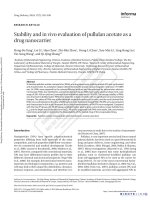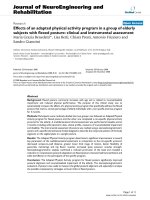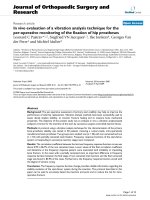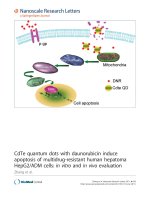An In Vivo Evaluation of an Aqueous Extract of Uncaria Tomentosa on the Morphology on the Labeling of Blood Constituents with 99m Technetium
Bạn đang xem bản rút gọn của tài liệu. Xem và tải ngay bản đầy đủ của tài liệu tại đây (501.1 KB, 5 trang )
Nature and Science, 2(1), 2004, Diré, et al, In Vivo Evaluation of an Aqueous Extract
An In Vivo Evaluation of an Aqueous Extract of Uncaria Tomentosa
on the Morphology on the Labeling of Blood Constituents
with 99m Technetium
Gláucio F. Diré 1, Hayden P. Honeycutt 2, Maria L. Gomes 1, Elaine A. C. Lima 1,
Deise M. M. Mattos 1 , Mario Bernardo-Filho 1, 3
(1. Universidade do Estado do Rio de Janeiro, Instituto de Biologia Alberto Alcantara Gomes, Departamento de
Biofisica e Biometria, Av. 28 de setembro n 87, 20551-030, Rio de Janeiro, Brasil;
2. University of North Carolina, School of Pharmacy, Chapel Hill 27599-7360, North Carolina, USA;
3. Instituto Nacional do Cõncer, Coordenadoria de Pesquisa, Praỗa Cruz Vermelha, 23, Rio de Janeiro,
RJ, Brasil, 20230-130. E-mail: )
Abstract: Uncaria tomentosa (Cat’s Claw, Unha de Gato) is a commonly used medicinal plant, which has
demonstrated to have antioxidant and antimutagenic properties. Blood cells (BC) labeling with
99m
Tc(technetium-99m) has progressed around the world. The influence of drugs on the labeling of blood
elements with 99mTc has been reported. The purpose of this study was to examine the effect of Unha de
Gato extract on the radiolabeling of blood elements with 99mTc and on the morphology of red blood cell
(RBC). Extract (32 mg/mL) was prepared with NaCl (0.9%). The extract was administered to the animals
via gavage (for seven days). Blood was withdrawn and it was incubated with stannous chloride for one
hour followed by the addition of 99mTc. Plasma (P) and BC were separated. P and cell (C) were precipitated
with 5% trichloroacetic acid (TCA) and soluble fraction (SF) and insoluble fraction (IF) were obtained.
The percentage of radioactivity (%ATI) was determined. For the morphology the smears were evaluated
and RBCs were analyzed. We can conclude that Uncaria extract was not capable to alter the radiolabeling
of blood elements with 99mTc and the morphology of red blood cells. We suggest that the studied natural
product, may be heavily metabolized by the liver, resulting in inactive metabolites that do not alter the
labeling procedure and the morphology of RBCs. [Nature and Science, 2004,2(1):6-10].
Key words: Unha de Gato; red blood cells; plasma proteins; technetium-99m
·6·
1
Introduction
Many plant species are used medicinally. In Brazil
there are many vegetables that are traditionally used in
folk medicine. Uncaria tomentosa (Unha de Gato) from
Rubiaceae family is a plant from the Peruvian Amazon.
Cat’s Claw is a commonly used medicinal plant for a
variety of indications including, rheumatoid and
osteoarthritis, sinusitis, rhinitis, tonsillitis, and cutaneous
abscesses. It has previously been demonstrated to have
immunostimulant, antioxidant, and more recently
antimutagenic properties. It has been demonstrated that
Uncaria has a potential antiviral and immunomodulating
activity (Williams, 2001). The biodistribution of the
radiopharmaceuticals can be altered by natural and
synthetic drugs as well as the radiolabeling of blood
elements with technetium-99m (99mTc) (Diré, 2001;
Mattos, 1997, 2000, 2002; Vidal, 1998). When a
radionuclide have its capability to bind to blood
elements altered by drugs therapy, the process of labeled
red blood cells may be repeated, resulting in an
additional radiation dose to the patient (Early, 1995;
Hesselewwod, 1994).
99m Tc has been the most utilized radionuclide
in nuclear medicine procedures and it has also been used
in basic research (Early, 1995; Gutfilen, 1996; Mattos,
2001; Saha, 1998). The wide utilized in nuclear
medicine is due to its optimal physical characteristics
(half-life of 6 h, gamma rays energy of 140 keV and
minimal dose to the patients), convenient availability
from
99Mo/99mTc
generator
and
negligible
environmental impact. Nearly almost all scanning
devices currently in use are optimized for detecting the
eletromagnetic emission from this radionuclide (Early,
1995; Hesselewwod, 1994).
There are many applications of 99mTc-labeled red
blood cells (RBC). The most important is in
cardiovascular nuclear medicine, where one tries to
image the heart to determine its functional status as a
pump, to calculate the left ventricular function by
measuring the ejection fractions, and to evaluate wall
motion abnormalities. Some other applications are in
the detection of gastrointestinal bleeding, and in the
determination of the RBC mass in patients (Early,
1995; Hesselewwod, 1994). The labeled process with
99mTc depends on a reducing agent and stannous ion
(Sn2+), mainly as stannous chloride, is usually used
for this purpose (Early, 1995; Gutfilen, 1993, 1996;
Hesselewwod, 1994; Saha, 1998; Sampson, 1996).
When whole blood is used in the labeling of RBC
with 99mTc, radioactivity is found on blood cells,
however it is also bound on plasma proteins. This
labeling process depends on optimal stannous chloride
concentration and stannous and pertechnetate ions
across the RBC membrane, probably spending energy
and the radionuclide is mainly bound to hemoglobin
molecule (Gutfilen, 1996; Hesselewwod, 1994;
Hladik, 1987). Several of the cellular labeling steps
have been well characterized. The band-3 anion
transport system and calcium channels may be the
ways that 99mTc and Sn+2, respectively, reach the
interior of the RBC (Gutfilen, 1996; Srivastava,
1984). If one damages the RBC, one can do selective
spleen imaging since damaged cells are rapidly
sequestrated by the spleen. RBC has been labeled with
99mTc for in vitro in vivo or in vivo/ in vitro
techniques (Srivastava, 1984).
Plasma proteins (PP) have also been labeled with
the referred radionuclide. 99mTc -labeled PP has been
used to locate placenta, to evaluate the cardiac function
and pulmonary perfusion, to determine blood volume
and to study the gastrointestinal protein loss (Early,
1995; Hesselewwod, 1994).
The labeling of red blood cells with 99mTc has
been influenced by patient medications, by the labeling
conditions (Early, 1995; Hesselewwod, 1994; Santos,
1995) or by the presence of extracts of plants, as
Paullinia cupana (Mattos, 2002), Maytenus ilicifolia
(Mattos, 2000), Thuya occidentalis (Mattos, 1997),
Nicotiana tabacum (Vidal, 1998), and. Nevertheless,
there is not a well established in vitro/in vivo model to
study the interaction of therapeutic drugs with
radiopharmaceuticals (Early, 1995; Sampson, 1996; Santos, 1995). Then, we
have evaluated the influence of an Uncaria extract (i) on
the labeling of blood elements with 99mTc and (ii) on
the morphology of RBC.
2
Material and Methods
2.1 Plant material
A commercial dried powder of Unha de Gato was
obtained from the Laboratory Herbarium, Laboratório
Botânico, Brazil, Lot 923661 (June, 2001 and validity
June 2004). To prepare the solution which was
considered like 100% it was diluted 320 mg of Uncaria
into 10 mL of saline solution (NaCl 0.9%) obtained a
solution 100% (32 mg/mL).
2.2 Animals
Male Wistar rats (200-250 g) from Universidade do
Estado do Rio de Janeiro were used. The animals
received a standard pellet rat diet and water, they were
maintained under constant environmental conditions
(22±5°C, 12 h of light/dark cycle).
In six male Wistar rats were administered 1 mL of
Unha de Gato solution via oral gavage for seven days.
Similarly, six other male rats were treated with normal
saline to serve as control.
2.3 Study protocol
Samples of heparinized (0.5 mL) blood were
withdrawn from animals and incubated with 0.5 mL of
stannous chloride (1.2 g/mL), as SnCl2.2H2O for 1 h at
room temperature. After this period of time, 99mTc (0.1
mL), as sodium pertechnetate, was added and the
incubation continued for another 10 min. These samples
were centrifuged and plasma (P) and blood cells (BC)
were separated. Samples (20 l) of P and BC were
precipitated with 1 mL of trichloroacetic acid (TCA) 5%
and soluble fraction (SF) and insoluble fraction (IF)
were separated. The radioactivity in P, BC, IF-P, SF-P,
IF-BC and SF-BC were determined in a well counter.
After that, the % of radioactivity (%ATI) was calculated.
A statistical analysis (Mann Whitney and Kruskal Wallis
tests) was utilized to compare the experimental data.
For the morphology study, the blood was collected
from the same rats treated with Unha de Gato and saline
solution. Blood smears were prepared, dried, fixed and
staining. Five slides per rat were analyzed for a total of
60 slides. Five frames were evaluated per slide
andthemorphology of the red blood cells observed in
each frame was quantitatively analyzed under optical
microscope by Image Pro-Plus software.
3
Results
Samples of whole blood from the animals
(control
and treated with uncaria extract) were incubated with
SnCl2 for 1h and after with 99mTcO4Na. Blood smears
were prepared, dried, fixed and staining. After that, the
morphology of RBC was evaluated under optical
microscope (x1000) (Figure 1, 2).
Table 1 has shown the effect of uncaria (in vivo) on
the labeling of red blood cells (BC), insoluble fraction of
the red blood cells (IF-C) and in the insoluble fraction of
the plasma (IF-P) with 99mTc. The analysis of the
results indicates that the referred extract is not capable to
reduce the labeling efficiency of blood elements with
99mTc.
Table 2 has shown the morphology of red cells of
the blood withdrawn from animals that have received the
extract (7 days), by gavage via. The analysis of the
results indicates that there is no alteration in the
morphometric analysis (p>0.05) when the control group
was compared with the treated one.
4
Discussion
Many authors have described a great number of
drugs which can be due to the causes of some diseases of
red cells (Bernardo, 1994; Braga, 2000; Sampson, 1996).
There are evidences that drugs can affect either
radiolabeling or biodistribution of blood cells in the
context of the nuclear medicine. In the literature some
researches have turned their attention to in vitro testing
of the drug with labeled cells (Bernardo, 1994; Braga,
2000; Hladik, 1987; Sampson, 1996).
Figure 1 – control
Figures 1 and 2
Figure 2 - treated
Photomicrography of blood smears prepared with samples of whole blood
used to label RBC with 99m Tc (control and treated)
Table 1 Effect of uncaria (in vivo) on the labeling of red blood cells (BC), insoluble fraction
of the red blood cells (IF-C) and in the insoluble fraction of the plasma (IF-P) with 99mTc.
Sechium edule
Control
100 %
BC
IF-C
IF-P
91.62 3.90
97.01 0.70
79.50 1.84
83.30 0.90
71.43 0.37
72.70 0.43
Samples of heparinized blood from animals treated with the referred extract were incubated for 1 hour with stannous chloride (1.2
g/mL) and 99mTc, as sodium pertechnetate. These samples were centrifuged and plasma (P) and blood cells (BC) were separated.
Samples (20 l) of BC were precipitated with trichloroacetic acid (TCA) 5% and soluble (SF) and insoluble fractions (IF) were
separated. The radioactivity in P, BC, SF-BC , IF-BC, SF-P and IF-P was determined in a well counter and the % of radioactivity (%
ATI) was calculated. A statistical analysis (Kruskal Wallis test, n= 6) was used to compare the results. The values are averages SDs.
Table 2 - Effect of uncaria (in vivo) on the morphology of red blood cells (BC)
Groups
Control
Treated (100 % )
Mean of the perimeter/area
0.65 ± 0.04
0.63 ± 0.02
Histological evaluations were performed with blood samples treated with Uncaria for 60 min at room temperature. Blood smears
were prepared, dried, fixed and staining. After that, the morphology of the red blood cells was observed under optical microscope.
The use of natural products, as medicinal plants, is
very frequent in folk medicine around the world and
Uncaria is utilized as a therapeutic plant due to this
antiinflammatory properties such as rheumatoid and
osteoarthritis, sinusitis, rhinitis, amigdalite, and
cutaneous abscesses (Williams, 2001).
It has been described by our research group the
effect of some natural products as Thuya occidentalis
(Mattos, 1997), Nicotiana tabacum, (Vidal, 1998),
Maytenus ilicifolia (Mattos, 2000) and Paullinia cupana
(Mattos, 2002) on the radiolabeling of blood elements
with 99mTc. These extracts are capable to reduce this
labeling procedure in in vitro studies.
In the present study, uncaria extract was not
capable to alter the radiolabeling of blood constituents
with 99mTc like it was observed with an extract of
cauliflower (leaf) (Lima, 2002). The results obtained
with the quality and quantity comparison of the shape of
the RBC (control and treated groups) under optical
microscopy could justify the fact that uncaria extract
was not capable to alter the radiolabeling procedure. In
other study, Diré et al, 2001 has reported that chayote
extract was able to alter de morphology of red cells.
Thompson et al., 1981 studied the labeling of intact
human erythrocytes with 99mTc. The analysis of the
membranes of labeled erythrocytes showed that the
label bear is not due to the binding of technetium to
residual hemoglobin but its binding to constituent
membrane proteins demonstrating the importance of the
integrity of the morphology of the cells due to
radiolabeling process. We can suggest that like Peumus
boldus (Reiniger, 1999), the effect of uncaria could be
explained by its anti-oxidant properties that can be due
to the fact that uncaria may be heavily metabolized by
the liver, resulting in inactive metabolites that do not
alter the labeling of blood elements with 99mTc.
Many reports about medicine plants are rarely
written up in the traditional medicine literature. In
order to make an accurate assessment of the impact of
drugs and other factors on the biological systems
additional data are required (Braga, 2000, Sampson,
1996).
[9]
Lima EAC, Diré G, Mattos DMM, Freitas R, Gomes ML,
Oliveira MB, Faria MVC, Jales RL, Bernardo-Filho M. Effect of
an extract of cauliflower (leaf) on the labeling of blood elements
with
technetium-99m and on the survival of Escherichia coli AB1157
submitted to the treatment with stannous chloride. Food Chem
Toxicolv , 2002;40:919-923.
[10]
Mattos DMM, Gomes ML, Freitas RS, Moreno S, Lima-Filho
GL, Paula EF, Jales RLC, Bernardo-Filho. Which are the most
used radionuclides in the pet and in the spect techniques in the
world. J Labeled Cpd Radiopharm , 2001 , Suppl 1:44.
[11]
Oliveira JF, Ávila AS, Braga ACS, Oliveira MBN,
Boasquevisque EM, Jales RL, Cardoso VN, Bernardo-Filho M.
5
Conclusion
Effect of extract of medicinal plants on the labeling of blood
elements with Technetium-99m and on the morphology of red
We can conclude that Uncaria extract was not
capable to alter the radiolabeling of blood elements with
99m
Tc and the morphology of red blood cells. We suggest
that the studied natural product, may be heavily
metabolized by the liver, resulting in inactive
metabolites that do not alter the labeling procedure and
the morphology of red blood cells.
blood cells: a study with Paullinia cupana Fitoterapia , 2002 ,
73:305.
[12] Oliveira JF, Braga ACS, Ávila ASR, Araújo AC, Cardoso VN,
Bezerra RJAC, Bernardo-Filho M. Assessment of the effect of
Maytenus ilicifolia (espineira santa) extract on the labeling of red
blood cells and plasma proteins with technetium-99m. J
Ethnopharmacol , 2000 , 72:179.
[13] Oliveira JF, Braga ACS, Ávila ASR, Gutfilen B and Bernardo-
References
Filho M. Effect of Thuya occidentalis on the labeling of
[1] Bernardo Filho M, Gutfilen B, Maciel OS. Effect of different
red blood cells and plasma proteins with technetium-99m. Yale J
anticoagulants on the labeling of red blood cells and plasma
Biol Med , 1997 , 69:489.
proteins with Tc-99m. Nucl Med Comm , 1994 , 15:730.
[2]
Braga ACS, Oliveira MBN, Feliciano GD, Reninger IW, Fonseca
JF, Silva CR, Bernardo-Filho M. The effect of drugs on the
labeling of blood elements with technetium-99m. Curr Pharm
[3] Diré G, Lima E, Mattos D, Oliveira MB, Pereira MJ, Moreno,
Freitas R, Gomes ML, Bernardo-Filho M. J Labeled Compds
Early PJ, Sodee DB. Principles and Practice of Nuclear
Gutfilen B, Bernardo-Filho M. M Rer Bras Pesq Desenvolv,
Gutfilen B, Pontes LFS, Alencar ISC, Bernardo-Filho M.
S,
Leung
E.
Drug
interactions
with
radiopharmaceuticals. Eur J Nucl Med , 1994 , 21:348.
[8]
Hladik III WB, Saha GB, Study KT. Essentials of Nuclear
Medicine Science, Williams and Wilkings: Baltimore-London,
1987.
Radiopharm , 1984 , 21:1055.
MM. J Exp Clin Cancer Res , 1998 , 17:41.
[20] Williams JE. Review of antiviral and immunomodulating
Biomed Letter , 1993 , 48:305.
Hesselewwod
41:1575.
[19] Vidal MV, Gutfilen B, Barbosa-da-Fonseca LM, Bernardo-Filho
1996 , 3:93.
[7]
[17] Santos JS, Paula EF, Correa TG, Freitas LC, Fonseca LM,
[18] Srivastava SC, Straub RF, Richards PJ. Labeled Compds
Medicine. Mosby-Year Book, Inc., Toronto , 1995 , 877.
[6]
[16] Sampson CB. Nucl Med Commun , 1996 , 17:648.
Gutfilen B, Bernardo-Filho M. Braz J Med Biol Res , 1995 ,
Radiopharm , 2001, Suppl 1:44.
[5]
M. Appl Radiat Isto , 1999 , 51:145.
[15] Saha GB. Fundamentals of Nuclear Pharmacy. Springer-Verlag,
New York , 1998 , 331 .
Design , 2000 , 6:1179.
[4]
[14] Reiniger IW, Oliveira JF, Caldeira-de-Araújo A, Bernardo-Filho
properties of plants of the Peruvian rainforest with a particular
emphasis on Una de Gato and Sangre de Grado. Altern Med Rev
, 2001 , 6:567.









